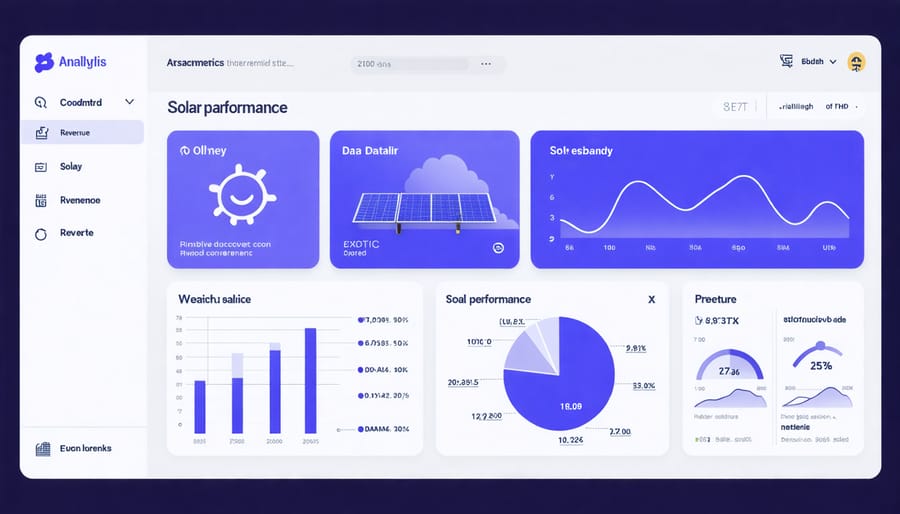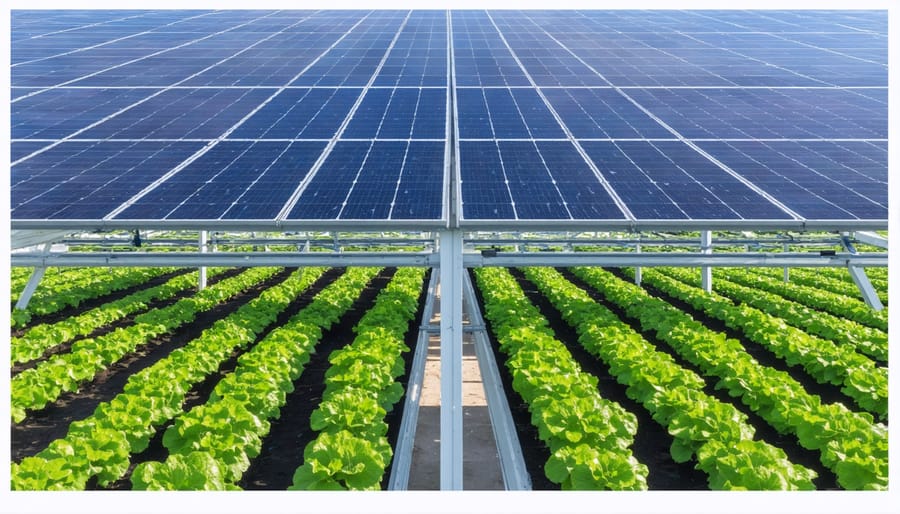Transform your solar installation from a cost center into a dynamic revenue generator by leveraging innovative monetization strategies that directly benefits your bottom line. Modern solar facilities create multiple revenue streams beyond basic energy generation: monetize excess power through grid feed-in tariffs, capitalize on renewable energy certificates, and leverage battery storage for peak demand arbitrage.
Forward-thinking organizations are discovering untapped potential in solar installations through data monetization, agricultural integration, and innovative financing models. By implementing comprehensive monitoring systems, facilities can generate valuable performance analytics for researchers and utilities while maintaining operational efficiency. Solar carports and agrivoltaic systems transform unused space into productive assets, generating both clean energy and additional income streams.
The evolution of distributed energy markets has created unprecedented opportunities for solar asset owners to participate in virtual power plants, demand response programs, and emerging carbon markets. These innovative revenue solutions not only accelerate ROI but position organizations at the forefront of the clean energy transition, creating sustainable competitive advantages in an increasingly carbon-conscious marketplace.
Turning Solar Heat into Profit Centers
Agricultural Applications
The integration of excess heat from solar installations into agricultural operations represents a significant opportunity for revenue generation and operational efficiency. Greenhouse facilities can utilize surplus thermal energy to maintain optimal growing temperatures year-round, reducing heating costs by up to 60% while enabling extended growing seasons. This application is particularly valuable in colder climates where traditional greenhouse operations face substantial energy expenses.
Crop drying operations benefit similarly from redirected excess heat, offering farmers a cost-effective solution for post-harvest processing. Modern solar-integrated drying systems can reduce moisture content in grains, fruits, and other agricultural products more efficiently than conventional methods, while maintaining product quality. A case study from a Minnesota farming cooperative demonstrated annual savings of $45,000 after implementing a solar-assisted drying system for their corn processing facility.
These agricultural applications create multiple revenue streams: direct energy cost savings, increased crop yield through extended growing seasons, and potential income from providing drying services to neighboring farms. Furthermore, many regions offer agricultural energy incentives that can enhance the financial returns of these installations. Forward-thinking facility managers are increasingly partnering with local agricultural businesses to create mutually beneficial arrangements, where excess heat is sold at rates below traditional energy costs while generating additional revenue for the solar installation.
The scalability of these solutions makes them viable for both small greenhouse operations and large-scale agricultural facilities, with ROI typically realized within 3-5 years of implementation.
Industrial Process Integration
Industrial facilities can significantly enhance their revenue streams by implementing heat recovery systems and participating in thermal energy trading networks. This innovative approach, which has become one of several proven solar business models, allows businesses to capture and monetize excess heat that would otherwise be wasted.
By establishing partnerships with neighboring industrial facilities, companies can sell their surplus thermal energy for various applications, including process heating, space heating, and water heating. This symbiotic relationship not only generates additional income but also improves overall energy efficiency across the industrial complex.
Case studies have shown remarkable success in this area. For instance, a paper mill in Sweden successfully implemented a heat recovery system that supplies excess process heat to a nearby district heating network, generating an additional €2 million in annual revenue. Similarly, a food processing plant in Denmark covers 30% of its operating costs by selling excess heat to adjacent manufacturing facilities.
The key to successful implementation lies in careful planning and infrastructure development. This includes installing heat exchangers, implementing monitoring systems, and establishing clear agreements with potential buyers. The return on investment typically ranges from 2-5 years, depending on the scale of operations and local energy prices.
To maximize benefits, facilities should conduct comprehensive energy audits to identify heat recovery opportunities and potential industrial partners within a viable radius. Modern digital platforms and smart grid technologies have made it easier to manage these thermal energy transactions efficiently.


Data-Driven Revenue Opportunities
Weather Data Monetization
Solar installations equipped with advanced monitoring systems generate valuable weather and irradiance data that can create additional revenue streams. Research institutions, universities, and meteorological organizations often seek high-quality, location-specific data to support their studies and improve weather forecasting models.
This data monetization opportunity is particularly valuable because solar installations typically collect comprehensive datasets including solar irradiance levels, temperature variations, humidity, wind speed, and atmospheric conditions. These measurements, gathered continuously over extended periods, provide researchers with precise, real-world data that’s essential for climate research, renewable energy studies, and weather pattern analysis.
To capitalize on this opportunity, facility owners can establish data-sharing partnerships with academic institutions or sell their data through specialized meteorological data marketplaces. The revenue potential varies based on factors such as data quality, geographical location, and measurement frequency. Premium pricing is often available for facilities in areas with limited weather monitoring infrastructure or those offering particularly detailed or unique datasets.
Implementation requires minimal additional investment for facilities with existing monitoring systems. The key requirements include ensuring data accuracy through regular sensor calibration, maintaining consistent data collection protocols, and establishing secure data transmission methods. Many modern solar monitoring platforms already include features for data export and sharing, making it straightforward to begin monetizing this valuable resource.
This revenue stream not only provides financial benefits but also contributes to scientific research and advances in renewable energy technology.
Performance Analytics Services
Performance analytics services represent a significant opportunity to transform operational data into valuable consulting offerings. By leveraging advanced monitoring systems and data analytics platforms, organizations can create comprehensive performance reports that provide actionable insights for solar facility optimization.
These services typically include detailed analysis of energy production patterns, equipment efficiency metrics, and maintenance forecasting. The collected data enables the development of customized optimization strategies, helping clients maximize their solar investments through improved performance and reduced operational costs.
Organizations can package this expertise into tiered consulting services, ranging from basic performance monitoring to advanced predictive maintenance solutions. For example, a standard package might include monthly performance reports and basic optimization recommendations, while premium services could offer real-time monitoring, advanced failure prediction, and detailed ROI analysis.
The market value of these services continues to grow as facilities seek to optimize their operations. Successful implementations have shown that analytics-based consulting can improve overall system efficiency by 15-20% while reducing maintenance costs by up to 25%. This creates a win-win situation where both the service provider and client benefit from improved system performance.
To establish credibility in this space, organizations should focus on developing specialized expertise in data interpretation and practical optimization strategies. Building a portfolio of successful case studies and documented performance improvements will help demonstrate the value proposition to potential clients.
Space Optimization Revenue
Dual-Use Land Applications
Dual-use land applications represent a significant opportunity to maximize your solar investment by utilizing the same space for multiple purposes. Agrivoltaics, the combination of agriculture and solar installations, has emerged as a particularly promising solution. Farmers can maintain crop production while generating clean energy, effectively doubling their land’s productivity.
Recent studies show that certain crops, such as leafy greens and root vegetables, actually benefit from the partial shade provided by solar panels. For example, a Massachusetts farm reported a 60% increase in crop yield while generating enough electricity to power 70 homes through their agrivoltaic system.
Solar carports represent another successful dual-use application, transforming parking areas into power generation facilities. These structures provide shade for vehicles while producing clean energy, creating multiple revenue streams from a single space. Major retail chains have reported significant benefits from solar carport installations, including reduced energy costs, enhanced customer satisfaction, and additional income from electric vehicle charging stations.
These innovative approaches not only optimize land use but also create new revenue opportunities. Business owners can benefit from reduced operating costs, increased property value, and potential tax incentives while contributing to sustainable development goals.

Infrastructure Leasing
Solar infrastructure presents a unique opportunity for additional revenue generation through strategic leasing arrangements with telecommunications companies. The vertical space and elevated positioning of solar installations make them ideal locations for mounting cellular antennas, 5G equipment, and other communications infrastructure.
Many facility owners are discovering that their solar arrays can serve dual purposes: generating clean energy while providing valuable real estate for telecom equipment placement. This arrangement typically involves leasing agreements that can generate between $1,000 to $5,000 per month per installation, depending on location, accessibility, and market demand.
The key advantages of this revenue stream include minimal additional maintenance requirements, no interference with solar energy production, and long-term contract stability. Telecommunications companies often prefer these locations due to their existing electrical infrastructure and elevated positioning, which provides optimal signal coverage.
When implementing a telecom leasing strategy, consider:
– Structural integrity assessments to ensure support capability
– Access requirements for maintenance personnel
– Legal and zoning compliance
– Equipment interference prevention measures
– Insurance and liability considerations
Several successful implementations demonstrate the viability of this approach. For example, a commercial solar carport installation in California generates an additional $36,000 annually through telecommunications equipment leasing while maintaining its primary solar generation function.
Future-Ready Revenue Models
Energy Storage Solutions
Energy storage solutions have emerged as a lucrative revenue stream for solar installations, offering multiple pathways to generate additional income while enhancing grid stability. Battery storage systems enable businesses to participate in demand response programs, storing excess energy during low-demand periods and selling it back to the grid during peak hours when prices are highest.
Grid services represent a particularly promising opportunity, with utilities offering substantial incentives for facilities that can provide frequency regulation and voltage support. For example, a manufacturing facility in California generated an additional $175,000 annually by implementing a 2MW battery storage system and participating in the state’s demand response program.
The value stack of energy storage extends beyond simple arbitrage. Organizations can reduce demand charges by using stored energy during peak periods, potentially saving 20-30% on utility bills. Additionally, battery systems provide critical backup power, ensuring business continuity during grid outages and eliminating costly production interruptions.
Modern energy management systems optimize these revenue streams automatically, using artificial intelligence to predict grid demands and price fluctuations. This technology enables facilities to maximize returns while maintaining operational efficiency. Some facilities have achieved ROI periods as short as 3-4 years through strategic deployment of storage solutions.
As grid services markets mature and battery costs continue to decline, the revenue potential from energy storage is expected to grow significantly, making it an increasingly attractive investment for forward-thinking organizations.
Carbon Credit Opportunities
Carbon credit markets represent a significant opportunity for solar energy adopters to generate additional revenue streams while contributing to global sustainability goals. By participating in carbon offset programs, businesses can monetize their emissions reductions and maximize clean energy ROI through the sale of carbon credits.
Organizations can typically earn one carbon credit for each metric ton of CO2 emissions avoided through solar energy generation. These credits can then be traded on established carbon markets, where prices have shown steady growth in recent years. For example, the European Union Emissions Trading System (EU ETS) has seen carbon prices reach record levels, creating substantial revenue opportunities for credit holders.
To participate effectively in carbon markets, businesses should:
– Register their solar installations with recognized carbon offset programs
– Maintain detailed records of energy generation and emissions reduction
– Work with certified verification bodies to validate carbon credits
– Develop relationships with carbon credit brokers or trading platforms
Environmental certificates, such as Renewable Energy Certificates (RECs) and Guarantees of Origin (GOs), provide additional revenue streams. These certificates authenticate the renewable origin of generated electricity and can be sold separately from the power itself, creating a dual income stream for solar facility operators.
The growing corporate commitment to carbon neutrality has increased demand for both carbon credits and environmental certificates, making this revenue stream increasingly valuable for solar energy producers.
The path to maximizing solar installation revenue requires a strategic approach that combines established methods with emerging opportunities. By implementing the solutions discussed throughout this article, businesses can create multiple revenue streams while contributing to sustainability goals.
To capitalize on these opportunities, organizations should first conduct a comprehensive audit of their solar installation’s potential. This includes assessing available space for panel optimization, evaluating current energy consumption patterns, and identifying potential markets for renewable energy certificates.
Key action steps include:
– Developing partnerships with local utilities for grid services
– Implementing advanced monitoring systems for performance optimization
– Establishing relationships with agricultural partners for agrivoltaic projects
– Creating a detailed maintenance schedule to maximize system efficiency
– Exploring energy storage solutions to enhance revenue potential
The future of solar revenue generation lies in the integration of multiple strategies. Organizations that combine traditional power generation with innovative applications like water conservation, agricultural cooperation, and grid services position themselves for long-term success. As technology continues to advance and markets evolve, early adopters of these innovative solutions will gain competitive advantages.
Remember that successful implementation requires careful planning, regular assessment, and adaptation to changing market conditions. By taking a proactive approach to revenue optimization, organizations can transform their solar installations from simple power generators into dynamic assets that deliver multiple value streams.

